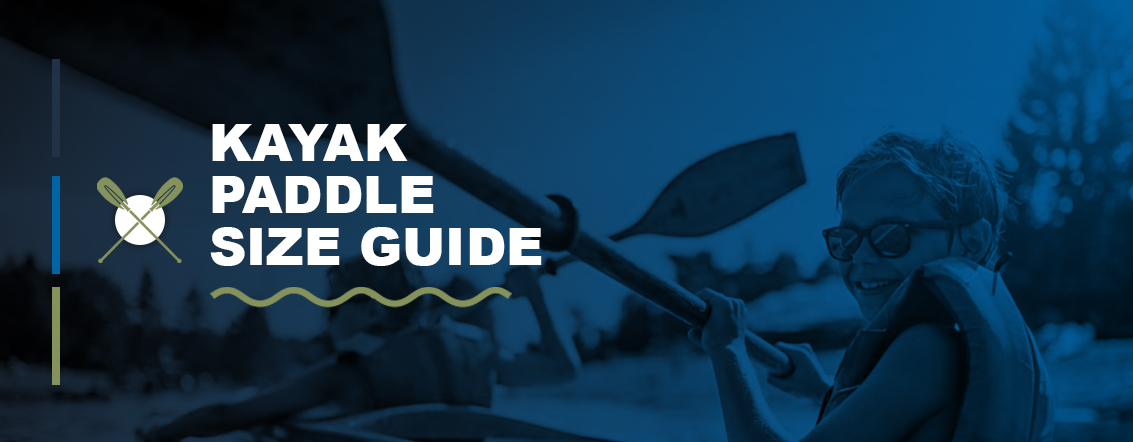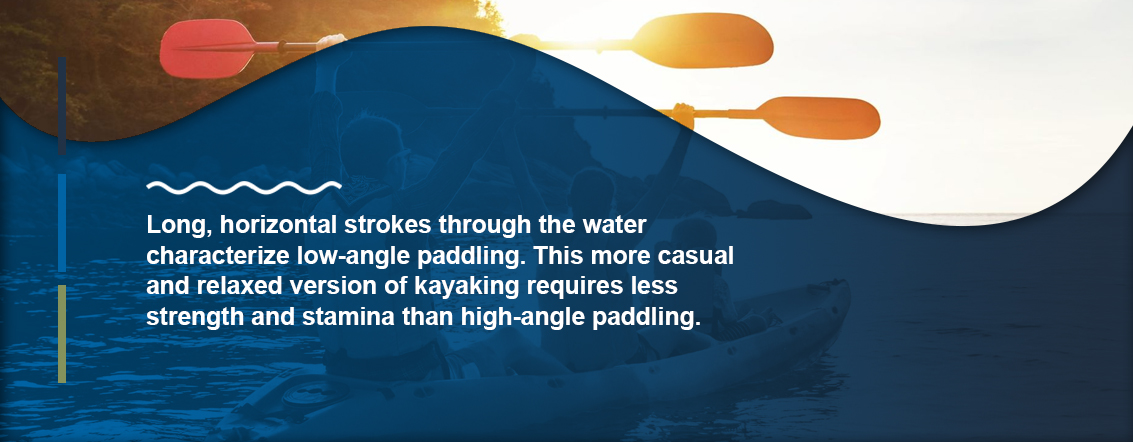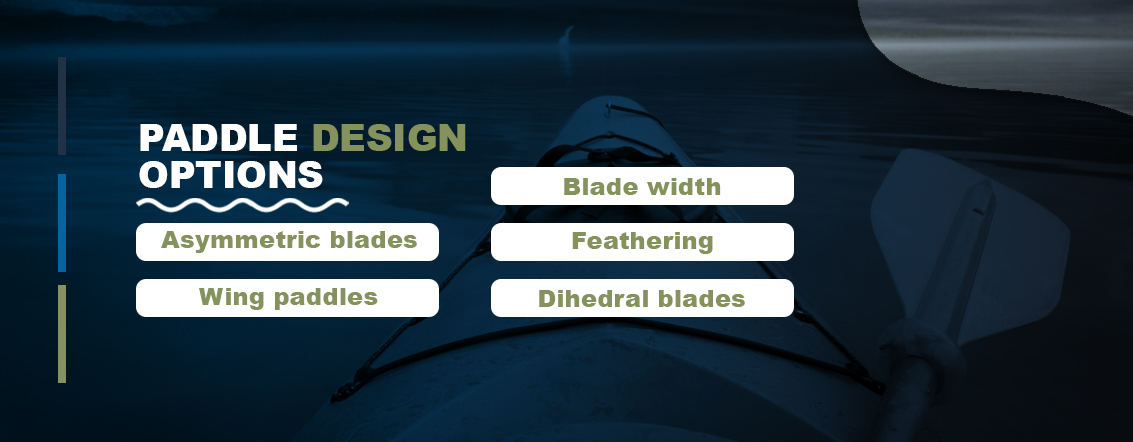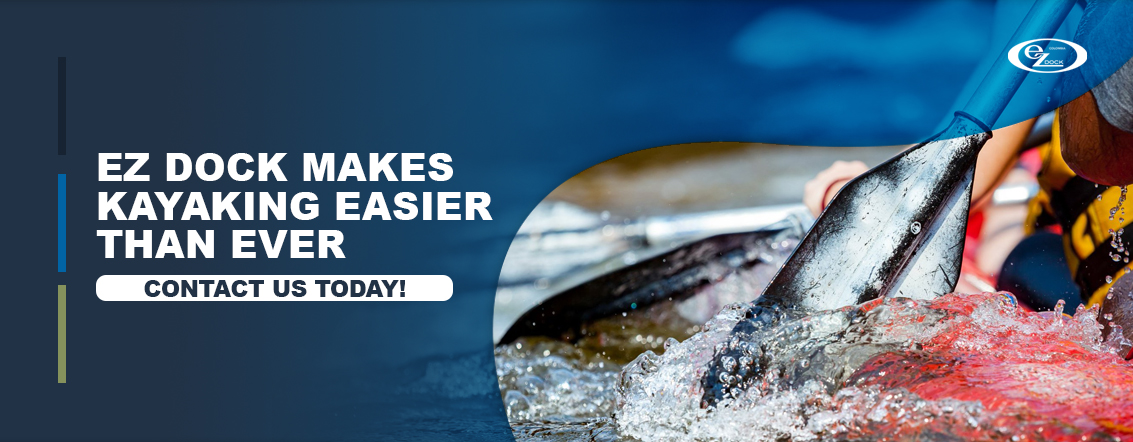Filters
Kayak Paddle Size Guide From EZ Dock
How to Determine What Kayak Paddle Size to Choose
Your kayak paddle is almost as important as the kayak itself. Kayakers depend on their paddles to help them navigate the water safely and return home. An incorrectly sized kayak paddle puts you at risk of having no control over your kayak or turning an otherwise fun adventure into an uncomfortable outing. Use this kayak paddle length guide to see why kayak sizing matters and to learn how to choose the perfect paddle for your day on the water.
Read the full guide or skip to a specific section:
- Why the Size of Your Kayak Paddle Matters
- How to Size a Kayak Paddle
- Kayak Paddle Tips: Low- vs. High-Angle Paddles
- Kayak Materials & Design
- Frequently Asked Questions About Kayaks and Paddle Sizing
- Learn How EZ Dock Makes Kayaking Easier Than Ever
Why the Size of Your Kayak Paddle Matters
By choosing an incorrectly sized paddle for your kayak, you risk losing the following.
- Comfort: Your comfort is essential for a successful kayak trip. A large part of that comfort rests on the way you handle your paddles. If your kayak paddles are too long, you might find yourself unable to lift and move them easily. Kayak paddles that are too short can lead to sore hands and knuckles from rubbing against the boat or back pain from having to lean too far over to reach the water.
- Control: If you can’t use your kayak paddles correctly, you could end up stuck on the water. Navigation, turning and directing your kayak all depend on correct paddle usage.
- Usability: Several factors come into play when sizing kayak paddles, including angling and experience level. If you choose a paddle intended for active boaters or deep-sea kayaking while you are a beginner preparing for your first casual trip on the lake, you are probably going to run into some difficulty.
How to Size a Kayak Paddle
You should consider a few different factors when selecting your kayak paddle, including the width of your kayak, your body measurements and whether you are a high- or low-angle paddler. If you need further help choosing the right kayak paddle, many outdoor shops hire staffers with experience in paddle sizing. Some places even hold “demo days,” where you can test out different kayaks and paddles on the water to get a feel for what you like.
Measure the Width of Your Kayak
The first step in kayak paddle sizing is to know your kayak. For the most accurate width measurement of your kayak, measure it at its widest point. Typically, the wider a kayak is, the longer your paddle will need to be to reach into the water on both sides without putting too much strain on your body. Once you have an accurate width measurement of your kayak, use that number to calculate the best paddle length for you by comparing it to your torso and body heights.
Find Your Body Measurements
Now that you have measured your kayak, it’s time to record your measurements. There are two different ways to measure yourself for kayak paddles: the height of your torso and the height of your body as a whole. You can use one measurement system exclusively, but for the best results, we recommend measuring your body height and supplementing that measurement with your torso height to find a corresponding size that falls within both height ranges on the kayak paddle size chart.
Measure Your Torso Height
Follow these instructions to find your torso height:
- Bend your head down and use your hands to find your top vertebra, where your shoulders meet your neck.
- Find the bottom of your torso by measuring your lumbar region. To do this, rest your hands on each of your hipbones with your index fingers and thumb pointing backward.
- Visually assess the space between each of your thumbs.
- Stand tall and ask someone to use a soft tape measure to measure the distance from your top vertebra and the imaginary line across your lumbar region.
Round your torso measurement to the nearest inch, and use it as your starting point for your paddle size.
- 22 inches: Try a paddle around 180 centimeters long. You’ll often find this size in the youth section.
- 24 inches: Look for a paddle between 180 and 200 centimeters in length.
- 26 inches: Look for a paddle between 190 and 210 centimeters long.
- 28 inches: Try a paddle that is around 200 to 220 centimeters in length.
- 32 inches: Look for a paddle between 220 and 240 centimeters in length.
- 34 inches: Choose a paddle that is between 230 and 250 centimeters long.
- 36 inches: Find a paddle that falls between 240 and 250 centimeters in length.
- 38 inches: You will probably be the most comfortable with a paddle that is 250 centimeters long.
Measure Your Body Height
Round your height to the nearest inch. Then, compare it to the width of your kayak and find the correct corresponding measurement.
If you are 5 feet 5 inches or shorter and your kayak is…
- 23 inches wide or smaller: Try a paddle that is 210 centimeters long.
- 24 to 32 inches wide: Try a paddle that is 220 centimeters long.
- 29 to 33 inches wide: Try a paddle that is 230 centimeters long.
- 34 inches or wider: Try a paddle that is 240 centimeters long.
If you are between 5 feet 5 inches and 5 feet 11 inches tall and your kayak is…
- 23 inches wide or smaller: Try a paddle that is 230 centimeters long.
- 24 to 32 inches wide: Try a paddle that is 240 centimeters long.
- 29 to 33 inches wide: Try a paddle that is 250 centimeters long.
- 34 inches or wider: Try a paddle that is 260 centimeters long.
If you are 6 foot or taller and your kayak is…
- 23 inches wide or smaller: Try a paddle that is 220 centimeters long.
- 24 to 32 inches wide: Try a paddle that is 230 centimeters long.
- 29 to 33 inches wide: Try a paddle that is 250 centimeters long.
- 34 inches or wider: Try a paddle that is 260 centimeters long.
Kayak Paddle Tips: Low- vs. High-Angle Paddles
The final thing you should account for is whether you plan to do more low-angle or high-angle paddling. If you aren’t sure whether a paddle is better for low- or high-angle paddling, most manufacturers list the intended use on the product tag.
Low-Angle Paddling
Long, horizontal strokes through the water characterize low-angle paddling. This more casual and relaxed version of kayaking requires less strength and stamina than high-angle paddling. For this reason, the low-angle method is ideal for long tours in low-intensity waters. When low-angle paddling, you use the leverage of your paddle to keep the shaft slightly tiled, while your leading hand remains below shoulder level at all times. Kayakers on the water for fun — rather than for sport or adrenaline-fueled adventure — usually prefer low-angle paddling, and they typically steer from the back of the kayak.
High-Angle Paddling
High-angle paddling is much faster and more rigorous than the low-angle method. Strokes are short, precise vertical movements, usually made from the front end of the kayak. If you’re a high-angle paddler, you use the water closest to the boat in quick, striking motions. Paddles with short shafts and wider blades are ideal for high-angle paddling, as they move through water smoother and faster than longer paddles. High-angle kayakers are those who kayak for sport or speed, like in competitive racing, whitewater touring and trips with more intense water conditions.
Kayak Materials and Design
The makeup of your paddle matters just as much as its size. As you choose your new paddle, consider the materials that compose the blade and shaft, as well as the paddle design.
Paddle and Shaft Options
The material of your paddle blade plays a large part in its performance, as well as your ability to handle it comfortably. Some of the most common paddle blade materials include the following.
- Fiberglass: Fiberglass is a favorite among kayakers because it is both lightweight and incredibly durable, but at a more affordable price compared to other materials.
- Aluminum: Aluminum is one of the best paddle materials for beginning kayakers because it is very cost-efficient. However, aluminum paddles tend to be quite heavy, making them difficult to handle for some.
- Carbon fiber: Carbon fiber or graphite paddles are more costly than other paddles and are a bit harder to find, but they are among the most lightweight paddles available.
- Wood: Wooden paddles are excellent for their style, strength and durability, but are often more expensive than other paddle types.
- Plastic: Plastic is another beginner-friendly paddle material. Although it is usually not as attractive as other paddle types, it is affordable and generally very lightweight.
The shaft of your paddle is the middle rod that connects your paddle blades and is where you place your hands when angling your paddle. Sometimes, a shaft will have a different material from the blade. Other times, the makeup will be consistent across the paddle. Shafts are either straight, or have a curve where your hands rest to promote wrist dexterity and ease the strain on your hands. Experiment with different blade and shaft makeups to see what feels best in your grip. A comfortable shaft is crucial if you want to minimize stress on your hands and arms, especially during long kayak tours.
Paddle Design Options
At first glance, kayak paddles might all look the same. Upon closer inspection, however, you will see some notable design differences.
- Blade width: Wider blades are perfect for high-angle paddlers because they create a lot more resistance as they move through the water than narrower blades do. This resistance is also what makes wider blades more physically taxing. Narrow blades are not as high-performance, but offer much less resistance, making them easier to use for long periods.
- Asymmetric blades: While canoe paddle blades tend to be more squared, many kayak blades are asymmetrical, with the height of a blade being at the top and tapering slightly toward the bottom.
- Feathering: “Feathering” refers to the offset twist of your paddle blades. Feathered paddles have rotated blades that slice through the water at a side angle, rather than straight down. Some paddles let you manually personalize the degree of feathering. Unfeathered blades are not rotated and have no offset. Some kayakers prefer a feathered paddle because of its ability to cut through the wind. Others prefer unfeathered because it is simpler to use and does not strain the wrist as much.
- Wing paddles: Racers and competitive kayakers almost exclusively use wing paddles because they provide a powerful forward stroke. However, for everyday recreational use, wing paddles are not usually the best choice.
- Dihedral blades: Dihedral paddle blades have a raised core, or spine, down the center that helps distribute water flow evenly over each side of the blade. While this creates less resistance, it also creates less stability. Navigation is a bit trickier with dihedral blades.
Frequently Asked Questions About Kayaks and Paddle Sizing
Still have questions? Here are some of the most frequently asked questions about kayaks and paddle sizing.
What Size Kayak Do I Need for My Height and Weight?
Your height does not factor into the kayak you choose in the same way that it does your paddles. As long as you are using your kayak for its designed purpose — fishing, whitewater exploration, recreational touring — you should be comfortable. Your weight, however, should factor into your kayak decision. Each kayak comes with a weight capacity limit. The good news is that there are several different types of kayaks to fit all body types and weights. Always be sure you check the weight limit before making your purchase. When doing so, you must remember to factor in the weight of your gear. A good rule to keep in mind is to take the weight limit number and subtract 125 to 150 pounds from it to account for your equipment. Then, check that your current body weight fits within that limit.
Are There Kayak Paddles for Kids?
There are kid-friendly kayak paddles. Critical factors to consider when selecting a paddle for your child are weight, paddle length and ease of holding. Children under 4 feet tall should avoid a paddle that is longer than 182 centimeters. Kids who fall between 4 and 4 and 1/2 feet tall are best off choosing paddles between 182 and 190 centimeters long. Children who are closer to 5 feet tall should choose a paddle between 190 and 210 centimeters. Children taller than 5 feet should follow the same size guidelines as adults.
What Is the Best Way to Paddle a Kayak?
As we learned earlier, there are different ways to paddle a kayak, including low and high angling and feathered and unfeathered blades. Keep these additional tips in mind to make any paddling experience more successful and comfortable.
- Maintain good posture: Good posture means sitting up straight and releasing the tension in your body. While you are paddling, avoid resting against the backrest. Keep your feet pressed firmly against the floor of the kayak, or against the footpegs.
- Avoid gripping your paddle too hard: While a firm grip is essential for maintaining control of your kayak, try not to keep your hands in a constant, tightly gripped state. A firm, yet light, hold is ideal. You should also try your best to keep your wrists straight while paddling. The tension created in bending your wrists or gripping your paddle too firmly will lead to choppier, less fluid movements in the water and will leave you with sore hands at the end of the day.
- Let your torso do the work: While you are sitting up straight, allow your torso to do a lot of the paddling work. As you make your paddle strokes, turn your torso, rather than using only your arms or shoulders.
EZ Dock Makes Kayaking Easier Than Ever
Do you love the idea of spending the day on the water, relaxing or adventuring in your kayak? So do we. That’s why EZ Dock has two different launch docks available for paddling enthusiasts.
The EZ Launch Dock is for all small watercraft, including kayaks and canoes. The EZ Launch Dock features:
- Guide rails for easier access in and out of the water
- The EZ Launch® Accessible Transfer System, which exceeds the Americans with Disabilities Act requirements for accessibility
- Launch rollers for smoother watercraft movement
- Floating platforms that adjust based on the current water level
The EZ Launch® Residential is specifically for kayakers, and offers:
- An innovative, one-piece design
- A docking system that adjusts to current water levels
- Built-in paddle notches to promote stability during launch
- A seamless design that allows for installation almost anywhere
Both the EZ Launch Dock and the EZ Launch® Residentialh Dock are stylish, low-maintenance and barefoot-friendly. If you’re interested in learning more about what an EZ Dock can do for you, visit us online today or locate an EZ Dock distributor near you.
















